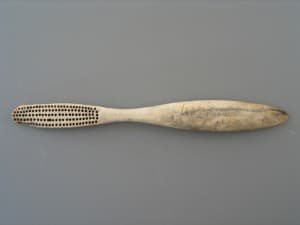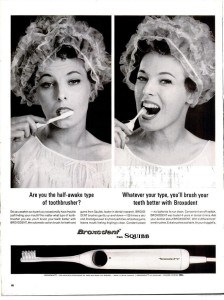Have you ever wondered how the toothbrush you use every day (twice, for two minutes) came to exist?
(twice, for two minutes) came to exist?
History of the Toothbrush
People have been practicing oral hygiene for over 5000 years! The earliest styles of toothbrush were made by chewing the end of a stick until it became frayed. The frayed end was them used to rub away debris and clean the teeth. This way of cleaning teeth dates back to the Egyptians and Babylonians. The Greeks on the other hand, used strips of linen, feathers, animal bones or porcupine quills as their dental instruments. (Rather inventive!)
 The modern toothbrush came about between the years 1498-1600 when the Chinese started pasting pig hair on a bamboo or animal bone handle. A man by the name of William Addis brought this newfangled idea to the English in 1780. Shortly thereafter, he found himself in prison and had plenty of time on his hands to further the design. Upon his release, he became the first person to mass-produce the modern toothbrush. Addis used the hair from a cow’s tail or horsehair, as they were softer than that from a pig.
The modern toothbrush came about between the years 1498-1600 when the Chinese started pasting pig hair on a bamboo or animal bone handle. A man by the name of William Addis brought this newfangled idea to the English in 1780. Shortly thereafter, he found himself in prison and had plenty of time on his hands to further the design. Upon his release, he became the first person to mass-produce the modern toothbrush. Addis used the hair from a cow’s tail or horsehair, as they were softer than that from a pig.
The first World War forced yet another change for the  modest toothbrush because animal bones were needed to make soup stock! (Don’t worry, toothbrushes aren’t in danger.) Celluloid became the new base of the handle. It was used by melting celluloid and then pouring it into molds. Bristles were inserted before the celluloid set, or holes were drilled and hair was stapled in after the celluloid had cooled. With bristles being made from animal hair, this excluded vegetarians. Muslims and Jewish people wouldn’t use them so the DuPont de Nemours company solved this problem with the introduction of nylon bristles. They named the new design ‘Dr. West’s Miracle-Tuft Toothbrush’ around 1938. (Whew!)
modest toothbrush because animal bones were needed to make soup stock! (Don’t worry, toothbrushes aren’t in danger.) Celluloid became the new base of the handle. It was used by melting celluloid and then pouring it into molds. Bristles were inserted before the celluloid set, or holes were drilled and hair was stapled in after the celluloid had cooled. With bristles being made from animal hair, this excluded vegetarians. Muslims and Jewish people wouldn’t use them so the DuPont de Nemours company solved this problem with the introduction of nylon bristles. They named the new design ‘Dr. West’s Miracle-Tuft Toothbrush’ around 1938. (Whew!)
 That brings us to the last stage of toothbrush evolution: The electric toothbrush. It started in Switzerland in 1939 and was available for purchase by the general population by the 1960’s. The first model was Broxodent, by the company Squibb, and their target market was the ‘overly-vigorous type of toothbrusher.’
That brings us to the last stage of toothbrush evolution: The electric toothbrush. It started in Switzerland in 1939 and was available for purchase by the general population by the 1960’s. The first model was Broxodent, by the company Squibb, and their target market was the ‘overly-vigorous type of toothbrusher.’
As of 2007, there are over 3000 patents related to toothbrushes! You can now find many brands and styles of toothbrush on the market.
So, next time you’re in need of a replacement brush, be thankful for the history of your brush!
Post written by: Tishena, lead assistant at White Dental Studio in Ashland, OR

Recent Comments